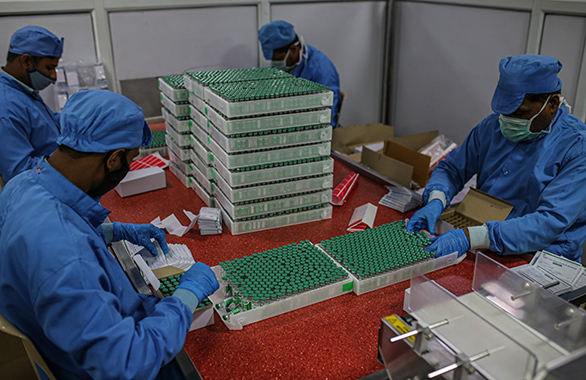
Employees packing boxes with Covid-19 vaccine at the packaging and dispatch department in Pune, Maharashtra, India, on Tuesday, 23 February 2021.

This paper outlines three areas – global coordination and leadership; financing and how to address key gaps in pandemic infrastructure – that will have the biggest impact on future global preparedness.
This paper outlines three areas – global coordination and leadership; financing; and how to address key gaps in pandemic infrastructure – that will have the biggest impact on future global preparedness.
This paper should be read alongside our policy paper on addressing Covid-19 vaccine inequity, which sets out the actions by G20 countries and vaccine manufacturers needed to rapidly increase global vaccination rates to reach 70% of the population in every country by mid-2022.
What’s inside
- Overview of changes and policy interventions to improve global pandemic preparedness and response proposed by expert panels in 2021
- Wellcome’s advice for policy makers as they consider action on global coordination and leadership, financing for global preparedness, and how to address key gaps in pandemic infrastructure.
Who this is for
- G20 officials and policy professionals
- Health advocates.
In this paper we have selected the biggest themes from four major expert reviews on pandemic preparedness and provide advice for how their recommendations should be taken forward by policy makers.
The biggest impact on future global preparedness can be achieved through reforms in three key areas:
Improving global coordination and leadership
- Given the cross-border nature of pandemics, new structures must be created to fill the gaps in multilateral coordination and provide a focus for countries to look beyond their immediate domestic interests.
- There should be a strong role for low- and middle-income governments in any new structures, to bring legitimacy and experience and expertise of tackling epidemics.
- A Council or Board should work through the existing global health architecture, such as the World Health Organization, the Global Fund, Gavi, CEPI, and not duplicate their work or activities.
- While governments consider the options proposed, this must lead to progress rather than paralysis and this must go hand-in-hand with additional financing.
Providing a sound financial footing for pandemic preparedness and response
- There is a strong rationale for pooled investment because all countries will benefit from global public goods for preparedness and there is a strong advantage working together to create them. New financing mechanisms should support key gaps in infrastructure for global preparedness and response, such as expanded global surveillance, and research into medical countermeasures, their supply and delivery.
- Governments’ contributions to a new financing mechanism should be in proportion with ability to pay and be additional to overseas development assistance, not compete with other critical health and development priorities.
- The new financing mechanism should remain focused on addressing critical gaps in the financing of global preparedness, including research and development.
Investing in the gaps in infrastructure to monitor and respond to threats
- The necessary infrastructure for global preparedness includes surveillance, research and development in infectious diseases, manufacturing, strong immunisation systems, and an ecosystem of people and knowledge needed to make it work.
- To guarantee that this infrastructure is maintained, it must be useful and used between pandemics.
- There is a need for a body focused on equitable and collaborative research, development and supply programmes to deliver a full range of countermeasures, such as diagnostics and vaccines, available to respond to a pandemic.

For more information, contact Alice Jamieson, Senior Policy Adviser at A.Jamieson@wellcome.org.